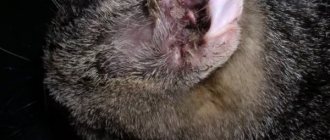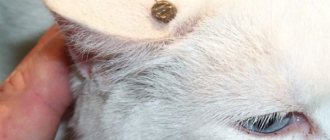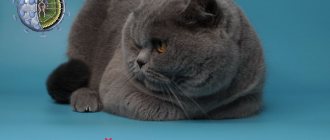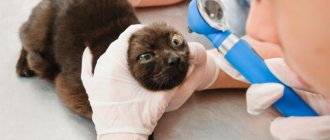What is feline otodectosis?
Feline otodectosis is a parasitic disease caused by the Otodectes cynotis mite and is a common and dangerous disease.
This representative of arthropods parasitizes not only the external auditory canal, but also the very ear of cats. As a result of its vital activity, cats experience characteristic symptoms. Cat ear mites are not dangerous to humans. The chance of infection is low. A person rarely encounters a disease. The parasite itself can rarely penetrate the human outer ear.
Why is otodectosis dangerous?
Ear mites in cats can provoke the development of purulent infections. Otodectosis with complications is dangerous due to the spread of infection to the middle and inner ear of the pet. If untreated, infection due to the activity of the tick can affect the membranes of the brain. A tick can cause damage to the integrity of a pet's eardrum.
Pathogen
The mite of the species Otodectes cynotis is the causative agent of the disease and leads a parasitic life in the ears of cats. An ear mite in cats looks like this: it has a wrinkled cuticle. The parasite has four pairs of legs. The first 2 pairs of legs have attachments, and the other two pairs are equipped with long bristles. Females are significantly larger in size than males. The length of females is in the range of 400-500 microns, the length of males is 300-395 microns. Females are much wider than males - 270-300 microns versus 215-295 microns.
Female mites are fertilized before molting. After just four days, the parasite produces larvae. They mature into adults in three weeks. Ear mites settle in the outer ear of a pet and begin to parasitize there.
Sources of infection and pathogenesis
Ear mites can be passed on to other cats. The main source of infection with otodectosis is other sick animals. A cat becomes infected with ticks due to close contact with relatives, dogs or other animals. Also, ear mites in cats appear due to their direct contact with any item of care. This could be a carrier, bedding, or a comb used to brush your pet. Also, infection with otodectosis occurs when a cat plays with a toy that has tick larvae. A person can infect a pet by carrying tick larvae on their clothes.
The parasite first bites through the skin with its mouth appendages, and then begins to feed on the secreted lymph and tissue fluid. The ear scabies mite not only mechanically affects the skin inside the auricle, but also has a toxic effect on it.
The consequence of the parasite's activity is irritation of nerve endings. The mite destroys the epidermis over time. The animal's sebaceous glands atrophy. The tissue fluid released from the affected areas of the skin dries and forms crusts. The animal actively combs them. All this leads to inflammation. The infection can subsequently affect both the middle and inner ear. The inflammatory process may spread to the membranes of the brain. These consequences of the disease lead to the occurrence of meningitis in the animal and to its death.
Causes and routes of infection
A dog of any age, gender, or breed can become infected with otodectosis. However, pets with weak immune systems are at risk.
In most cases, the pathology affects puppies and young animals up to one year old, whose natural defenses have not yet become sufficiently strong.
Ear scabies in dogs does not depend on the season - you can catch the mite at different times of the year.
Otodectosis is transmitted in the following ways:
- in close contact with an infected animal. The spreader can be either a dog or a cat;
- puppies often get the disease from their mother;
- through general care items;
- from the hands, clothes and shoes of the owner;
- on the street (dog walking area, grass, pile of garbage).
The main carriers of otodectosis are stray animals.
Symptoms of otodectosis in cats
Due to the activity of the parasite in the outer ear, the pet experiences an allergic reaction. The main irritants are saliva and tick waste products.
When otodectosis occurs in cats, the following symptoms occur:
- severe itching, due to which the animal often tries to scratch the ear with its paw;
- constant rubbing of the pet's ears against any objects with a rough surface;
- frequent head shaking;
- the presence of abrasions and scratches in the outer ear;
- suppuration in the area of the outer ear;
- the presence in the ears of dried black crusts from the remains of tissue fluid, skin and tick waste products.
If the infection spreads to the inner ear and membranes of the brain, signs of ear mites in cats such as depression, elevated body temperature and seizures are observed. The pet constantly tilts its head in the direction where its sore ear is located.
Where can you get infected?
Let's now look at where a cat can become infected with this mite.
- Option #1. If you bought a kitten, and it complains about its ears, then in this case the infection occurred from its mother, the cat.
- Option #2. If your pet left the house, even for 5 minutes. He went out to the entrance, went to the dacha, exhibition, mating, etc.
- Option #3. You picked up a stray animal and brought it home for a while, even for 5 minutes, and you already have a cat. This is also enough for your pet to receive a portion of ticks.
- Option number 4. There are 2 cats living in the house, one has constant problems with her ears, and the other is fine. This suggests that there is a hidden carrier in your family, i.e. He doesn’t get sick himself, but he constantly infects others. Can you guess who it is? Yes, it is the cat that does not complain about its ears that is the hidden carrier of the tick.
Diagnosis of otodectosis in cats
The diagnosis of “otodectosis” is made only based on the results of a microscopic examination of the pet’s ear. To do this, its contents are taken for analysis and checked for the presence of ticks and their larvae.
Additionally, the condition of the cat’s ear is diagnosed. One of the signs of otodectosis is the presence of scratches on it. Otodectosis in cats is also detected by external signs, including constant shaking of the animal’s head and regular attempts to scratch the sore ear.
Hygiene and care - how to rinse your ears before instilling medications
Before instilling medications, the ears must be cleared of accumulated secretions. Dried crusts and scabs are soaked with hydrogen peroxide, furatsilin or herbal infusion (see above). The antiseptic is applied strictly to a cotton swab, since the disc can accidentally push the purulent mass into the sink.
At first, it is better to enlist the help of a friend and put a muzzle on your pet. A small dog can be wrapped in a towel.
While processing, work from the inside out, being careful not to go too deep. Wash your hands thoroughly after each procedure and purchase an Elizabethan collar that prevents scratching of damaged areas.
Treatment of ear mites in a veterinary clinic
After examination and diagnosis, the veterinarian decides how to treat otodectosis in cats.
Treatment of ear mites in cats in a veterinary clinic is preferred in three stages:
- Prescription of systemic drugs. They have a poisonous effect on parasites. Drops are dripping onto the animal's . They are absorbed into the skin, penetrate the bloodstream and reach the parasites, causing their death.
- Carrying out hygiene procedures. The pet's ears are regularly cleaned of parasite waste products, as well as dead skin and blood residues.
- Treatment of the inside of the animal’s ears with antiparasitic solutions. The drugs also reduce swelling and itching inside the ear.
If otodectosis is accompanied by otitis media, the doctor will additionally treat with antibacterial drugs. If the integrity of the eardrum is damaged, surgical intervention with preliminary and subsequent washing of the tympanic bladder is required.
How to put drops in a dog's ear
Treatment of otodectosis using drops has its own characteristics. First of all, both auditory organs of the animal are treated, even if only one is infected. Before applying the medicine, study the instructions. Attention is paid to dosage and contraindications.
The procedure is carried out in several stages:
- Fix the dog's head in a stationary position.
- Bend back the edge of the ear.
- Drop the medicine in the volume specified in the instructions.
- Using massage movements, distribute the drops evenly.
Treatment of otodectosis in cats at home
Anti-ear mite medications for cats are available in the form of external solutions and drops. Ointment is also used to treat otodectosis. Folk remedies can be used in combination with drug therapy.
Top 5 External Ear Mite Solutions for Cats
You can treat ear mites in cats with the following external solutions:
- The drug Ivermek-spray. A clear or light yellow solution containing ivermectin, lidocaine, chlorhexidine and dexpanthenol. Ivermectin has an antiparasitic effect. Lidocaine eliminates pain and itching, chlorhexidine has an antimicrobial effect. Dexpanthenol has a healing effect. Before treatment, it is necessary to clean the outer ear of crusts. The spray is applied directly to the affected areas. When processing, it is necessary to capture 2 cm of a healthy area of the border skin. Two clicks on the spray bottle are enough. Treatment is carried out twice a day. The course of treatment is 5 days.
- Drug Stronghold. Antiparasitic solution of clear or pale yellow color. Contains selamectin, which has an antiparasitic effect. The drug is applied once to the cat’s withers. The dosage depends on the weight of the pet. For a kitten weighing less than 2.5 kg, 15 mg is enough. Cats weighing more than 2.6 kg need 45 mg. If necessary, the course of treatment is repeated after a month.
- Drops on the withers Lawyer. Contains imidacloprid and moxidectin, which cause paralysis and subsequent death of parasites. For small cats, the dose is 0.4 ml in each ear, for adults - 0.8 ml in each ear. The medicine is not injected into the ear canal. It is instilled into the area of the outer ear on the affected areas, previously cleaned of pus and dead skin.
- External drops Bars. Contains fipronil, which causes parasite paralysis. For a one-time treatment, kittens less than 1 kg need to put 10 drops behind the withers, pets weighing from 2 to 3 kg will need 20 drops, adults – 30. The medicine is applied to an open area of skin. Before treatment, it is necessary to part the fur and apply the preparation to the skin. After treatment, your pet should not be bathed for three days.
- External drops Inspector. Contains the ancaricide fipronil, which destroys parasites. Moxidectin causes paralysis of ticks and their death. Kittens weighing up to 1 kg need 1 drop of the product, cats weighing 1-4 kg need a whole pipette of the drug (0.4 ml), pets weighing from 4 to 8 kg need 0.8 ml. The medicine is buried under the withers. After treatment, your pet should not be bathed for five days.
Ear mite injections for cats are more effective. The medicine in the form of injections, Otodectin, is injected subcutaneously into the forearm area twice, followed by a 10-day break.
Top 10 ear mite drops for cats
To remove ear mites from a cat, check out our rating of the 10 best anti-otodectosis drops from the table below.
| Drug name | Description | Dosage | Mode of application |
| Amitrazine | Amitrazine is a yellowish oily liquid with a characteristic odor. Contains acaricide amitraz, which destroys parasites. The composition contains dimethyl sulfoxide, which relieves inflammation. Additionally contains rapeseed oil, which has a restorative effect. Before instillation, it is necessary to carefully clean the outer and inner ear from the remains of dead skin and pus. | Drops are instilled into each ear, 0.5 ml. | After instillation, it is necessary to bend the ear and gently massage it to improve penetration of the drug. Treatment is carried out once a day. The course of treatment is 5-7 days. |
| Fiprist | Contains fipronil, which has an antiparasitic effect. | 6 drops of medication are injected into each ear. | The medicine for otodectosis is applied only to ears that have been cleaned of crusts. Buried twice with an interval of 7 days. |
| Amit Forte | Amit Forte contains fipronil, which has an antiparasitic effect. The substance is not absorbed into the blood, but accumulates in the epidermis of the animal. The drug contains diphenhydramine, which has an anesthetic and anti-inflammatory effect. | 4 drops are placed in each ear. | Drops are instilled only into the pet’s previously cleaned ears. After applying them, you need to fold your ear in half and massage it. Treatment is carried out twice a day with an interval of 5 days. |
| Dekta Forte | Contains fipronil, as well as lidocaine and chloramphenicol. | Inject 5 drops into each ear hole. | It is buried in the ears, after which they are thoroughly massaged. The drug is used twice with a break of 5 days. |
| Dana Spot-on | Contains fipronil, which has an antiparasitic effect. The product is quickly absorbed into the skin. | 5 drops are injected into each ear hole. | It is instilled into both ears, after which they are thoroughly massaged for better absorption. The drug is used twice with a break of 7 days. |
| Otoferonol | Otoferonol contains cycloferon. The substance stimulates immune defense and eliminates inflammation. The composition contains deltamethrin, which causes paralysis of parasites. | 5 drops are instilled into each ear. | Drops are instilled into the cleaned ear canal twice a day for 7 days. |
| Tsipam | Contains cypermethrin as well as amitraz. The substances have antiparasitic and disinfectant effects. | 3 drops of medicine are instilled into each ear. | The product is used three times with a mandatory 7-day interval. The drug is instilled into previously cleaned ears. |
| Dekta | Contains levomethicin, amitraz and propolis. Anti-inflammatory drops have a complex effect, destroying microbes and parasites. | The product is used at a rate of 0.2 ml per 1 kg of pet weight. | The drug is used three times with a mandatory 7-day interval. |
| Surolan | The drug has a combined antimicrobial, antiparasitic and anti-inflammatory effect due to the miconazole, prednisolone and polymyxin it contains. | Drops of the drug should be instilled into each ear at a time. | The procedure is repeated every 5 days. The total duration of treatment is 14-21 days. |
| Neostomazan | Inexpensive drops contain transmix and tetramethrin, which have a detrimental effect on parasites. | The product is instilled 3 drops twice a day. | After each use of the drug, a 10-day break is required. Drops are instilled only into clean ears. |
In case of complications and development of otitis in pets due to otodectosis, effective drugs with an antibacterial effect are recommended in combination with the indicated drugs.
Top 5 ear mite ointments for cats
To treat otodectosis in cats, it is recommended to use the following agents:
- ointment . Contains permethrin with a pronounced acaricidal effect. The composition contains two antibiotics (neomycin and nystatin), as well as the anti-inflammatory substance triamcinolone. 0.5 cm of product is injected into each ear canal. The ointment is applied twice a day for 7 days.
- Aversectin ointment . Contains aversectin, which is a contact antiparasitic substance. The ointment is melted in hot water. The resulting liquid gruel, warm, is injected into the ears and rubbed. The treatment regimen is 7 days with twice daily use of the ointment.
- Amidel-gel. Contains cyfluthrin with a pronounced antiparasitic effect, the anesthetic lidocaine and the antibiotic chloramphenicol. The gel is applied in a thin layer to the previously cleaned damaged area of the ears. Treatment is carried out 2 to 5 times a day, after which a break of 7 days is taken.
- Syntomycin ointment. Contains the antibiotic chloramphenicol, which has an antimicrobial and healing effect. Apply a thin layer to previously cleaned ears. The ointment must be heated to 40°C before use. The remedy for ear mites is used twice a day with a mandatory break of 5 days.
- Ivermec-gel. Contains ivermectin, which has an antiparasitic effect. The composition also contains panthenol and lidocaine, which have analgesic and restorative effects. Apply 2 ml of gel into the ears. Apply twice with a 7-day break.
Neglected ear mites require combined treatment. Along with local medications, antibacterial agents are prescribed in the form of injections.
Top 5 folk remedies for ear mites for cats
Depending on the stage of the disease and the presence of complications, folk remedies can be used as a supplement and after consultation with a veterinarian.
Effective folk remedies for the treatment of otodectosis in cats:
- Honey. Only natural and high-quality products are used. A small amount of honey is applied to a cotton pad. It lubricates the entire surface of the cat's ears. Rubbing must be carried out for at least 15 minutes.
- Petrolatum. The product is applied in a small layer to a cotton pad and thoroughly rubbed into the damaged areas of the pet’s ears. The method is used for uncomplicated ear mites. The product has a calming effect.
- Aloe vera juice. A cotton pad is soaked in the fresh juice of the plant. The animal's ears are thoroughly wiped with it once or twice a day. The juice has antipruritic and anti-inflammatory effects.
- Apple vinegar. The solution is mixed with water in a 1:1 ratio. A cotton swab is moistened in it, which is used to wipe the pet’s ears every hour.
- A mixture of garlic and olive oil. A couple of garlic cloves are ground into porridge and mixed with a large spoon of olive oil. The composition is infused for a day. It is then passed through a sieve. Before use, the mixture is slightly heated in a water bath. The mixture is instilled into the ears, 4 drops daily. Treatment lasts from 14 to 21 days.
These remedies are effective only for uncomplicated forms and in the early stages of development of otodectosis in cats.
Prevention
It is impossible to completely prevent your pet from becoming infected with ear mites. However, with the help of preventive measures, you can reduce the likelihood of developing the disease. To do this you need:
- do not allow the dog to come into contact with unfamiliar relatives;
- periodically carefully examine the animal;
- If you find brown plaque in your four-legged friend’s ears, visit the clinic as soon as possible and undergo an examination;
- periodically carry out preventive cleaning with special preparations, which are selected together with a veterinarian, taking into account contraindications and other nuances.
The disease has a favorable prognosis if detected early and treated correctly. At the very beginning of the development of otodectosis, it happens that the ear mites disappear after one cleansing procedure and use of the drug. In advanced cases, you need to be patient, follow the rules of hygiene for your pet’s ears, adhere to the treatment regimen, and increase the dog’s immunity.
Possible complications
In addition to meningitis, the animal may also face other dangerous complications. These include:
- partial or complete deafness;
- dermatitis and allergies;
- purulent otitis;
- weakening of the body's defenses against the background of extensive intoxication;
- secondary infections;
- formation of ear plugs;
- inflammation and rupture of the eardrum.
Remember that puppies and older dogs tolerate the disease much worse than healthy animals. Because of this, they often die from the consequences in a very short time.










